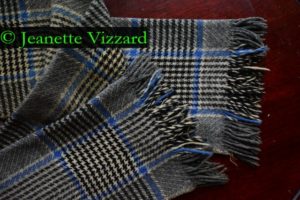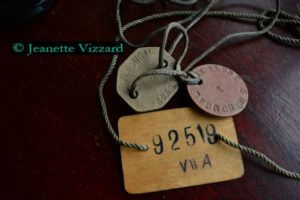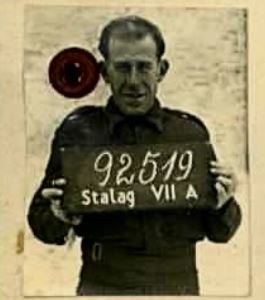This Blue Scarf
This blue scarf, a coat and a cap were hung on a peg one morning in a railway yard in Germany during World War II where Australian prisoners of war were working. The civilian worker who put them there went home cold that evening. 
This blue scarf, a coat and a cap were stolen that day by my father.
Why? Because they would become part of a stash of items he needed for his escape. He had already buried chocolate, raisins and a can of bully beef. These items amongst others were going to sustain him in his ‘Grab for Freedom’ from a labour camp associated with the prisoner of war camp Stalag VIIA and the blue scarf, the coat and the cap would allow him to pass unnoticed through Germany and on to the Swiss border and freedom.
My father wrapped that blue scarf around his neck and made his escape. He hid in a stone quarry above the railway yard and when it was safe to do so, jumped on the back of a train. Later, he blackened his face and hid in a wagon load of potatoes.
His luck held when the train stopped right outside a civilian clocking-in station, the busiest part of the railway yard. How it was that no-one saw him scrambling out of that wagon seems inconceivable. Perhaps a foreign worker decided to keep quiet about it. Whatever the case, my father couldn’t believe his luck.
In the compartment on another train he was bullied by some drunks and when they got off, started talking to the ticket collector. My father expected to be dragged off the train at the next stop. But his luck held.
And again, when he was discovered alone on a stationery train at night. A shot was fired as he leapt from the train and ran, under stationary wagons, over railway lines, on through the railway yard and finally, lungs bursting with the exertion, into the safety of the forest.
His luck held when he decided to ride as a passenger on another train. A ticket collector came by and my father, head against the window, pretended to be asleep. ‘Sleeping, sleeping, people are always sleeping’ muttered the guard as he let me father be.
But my father’s luck ran out within sight of the border, just as he started to believe he was going to make it into Switzerland. Fearing crossing a creek at night in steep mountainous country he returned in the morning to find the creek presented no problem but around the next bend he encountered a German frontier guard and his snarling dog.
No use now, the blue scarf, the coat and the cap, in fact, they worked against my father. During a five-hour interrogation where he stood naked and shivering in a ‘cold cheerless room’ his interrogator, an Oxford-accented German SS officer accused him of being a civilian saboteur, a spy, and not an Australian soldier. After all, reasoned the officer he had been dressed as a civilian and been caught in an area where no Australian or British soldier had been caught before. The captain was not pleased, nor as he told my father was the Third Reich. So displeased was this officer, that at one stage my father thought he may be shot! Such was the tension in the room. But, of course he was able to produce his Army dog tags and his Prisoner of War disc. 
But the charge of sabotage stuck, and it was now brought to light that my father had broken a large crate of glass whilst working as a railway goods porter and that he had been caught placing sand and loose nuts and bolts into the open-crated aeroplane engines. Time for punishment. He had already served time in solitary confinement in cold cells before being brought back to the camp and it was now decided he be sent off do hard labour at a stone quarry near Linz, but that is another story.
The blue scarf travelled with my father after he left the quarry to the next camp Stalag VIIIB, Lamsdorf and then on what is known as ‘The Long March’ – a forced march of prisoners of over 850kms at the end of the war and finally, to camp IXA at Ziegenhein. When the camp was liberated my father was sent to Wales and England to recuperate. Then home to Australia in June 1945, the blue scarf still with him.
As I write this, I can look across my living room and see that blue scarf in my glass-fronted bookcase. What a special piece of family stuff!
References
McDougal, Stephen Walter, Grab for Freedom, Good Weekend, Sydney Morning Herald, 26 August 1989.
McDougal, SW, ‘Rock City’; an experience, Blindheim, Germany Jan – Feb – Mar 1943. Unpublished article.
McDougal, SW, Untitled, unfinished and unpublished article. June-July 1986.
There is a lot on the web about Stalag VIIA – wikiepedia and moosburg online.
The Long March – Lamsdorf and The Long March to Freedom trailer – YouTube
 D5 Creation
D5 Creation
Comments are Closed